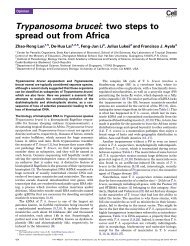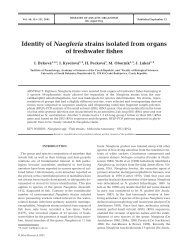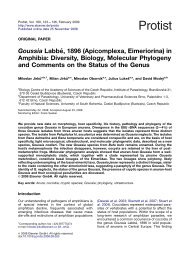Translational initiation in Leishmania tarentolae and Phytomonas ...
Translational initiation in Leishmania tarentolae and Phytomonas ...
Translational initiation in Leishmania tarentolae and Phytomonas ...
Create successful ePaper yourself
Turn your PDF publications into a flip-book with our unique Google optimized e-Paper software.
4 J. Lukeˇs et al. / Molecular & Biochemical Parasitology xxx (2006) xxx–xxx<br />
all possible sequences of this region. This exhaustive series<br />
was obta<strong>in</strong>ed by <strong>in</strong>sert<strong>in</strong>g the EGFP gene cassettes amplified<br />
with r<strong>and</strong>omized primers <strong>in</strong>to a <strong>Leishmania</strong> expression vector<br />
pF4X1.4sat [21]. In all 64 plasmids, the entire EGFP gene <strong>and</strong><br />
the 5 ′ <strong>and</strong> 3 ′ fusions with the UTRs were verified by sequenc<strong>in</strong>g.<br />
These EGFP expression constructs were stably <strong>in</strong>tegrated<br />
<strong>in</strong>to the small subunit ribosomal RNA (SSU) gene of the rDNA<br />
locus of L. <strong>tarentolae</strong> by homologous recomb<strong>in</strong>ation [21]. Correct<br />
<strong>in</strong>tegration <strong>in</strong> this locus has been confirmed by a diagnostic<br />
PCR us<strong>in</strong>g one primer anneal<strong>in</strong>g <strong>in</strong>side the expression cassette<br />
<strong>and</strong> one primer anneal<strong>in</strong>g to a sequence not present <strong>in</strong> the plasmid<br />
(data not shown). In this configuration, transcription of the<br />
cloned gene is under the control of a strong PolI promoter that<br />
drives transcription of the ribosomal RNA genes. Transcription<br />
of a reporter gene by this polymerase is about 10 times higher<br />
than the read-through transcription by Pol II [29]. Although <strong>in</strong><br />
all so far analyzed cases the transformation of L. <strong>tarentolae</strong> with<br />
pF4X1.4sat resulted <strong>in</strong> the s<strong>in</strong>gle <strong>in</strong>tegration of the construct per<br />
genome it cannot be automatically excluded that not all SSU loci<br />
<strong>in</strong> the genome were transcribed at the same levels. Therefore,<br />
we chose not to obta<strong>in</strong> clones from the nourseothric<strong>in</strong>-resistant<br />
population but rather to analyze all drug-resistant cells of a cell<br />
l<strong>in</strong>e result<strong>in</strong>g from a s<strong>in</strong>gle transfection. This ensures averag<strong>in</strong>g<br />
over many <strong>in</strong>dividual <strong>in</strong>tegration events, predicted to be <strong>in</strong> the<br />
range of 10 4 on the basis of st<strong>and</strong>ard transfection efficiencies<br />
obta<strong>in</strong>ed with the protocol used [24].<br />
In the recomb<strong>in</strong>ant cultures, fluorescence was usually<br />
detectable with<strong>in</strong> 1–2 days after electroporation. When the transfectants<br />
were <strong>in</strong>spected under a fluorescence microscope, some<br />
differences <strong>in</strong> the <strong>in</strong>tensity of EGFP expression <strong>in</strong> <strong>in</strong>dividual<br />
cells were observed, but most cells fluoresced to the same extent.<br />
However, a similar spread was also observed when a clonal population<br />
was analyzed, probably reflect<strong>in</strong>g the difference <strong>in</strong> EGFP<br />
expression at different stages of the cell cycle (data not shown).<br />
In all transfected cell l<strong>in</strong>es, the EGFP prote<strong>in</strong> was detected<br />
<strong>and</strong> quantified by measur<strong>in</strong>g its fluorescence <strong>in</strong> liv<strong>in</strong>g cells, <strong>and</strong><br />
<strong>in</strong> a subset of stra<strong>in</strong>s also by estimat<strong>in</strong>g the amount of the prote<strong>in</strong><br />
<strong>in</strong> cell lysates us<strong>in</strong>g Western blott<strong>in</strong>g with the anti-EGFP antibodies.<br />
The reproducibility of the expression phenotypes was<br />
verified with 15 cultures exhibit<strong>in</strong>g either strong, medium or<br />
weak EGFP expression (Fig. 1A). The load<strong>in</strong>g was controlled<br />
by reprob<strong>in</strong>g the membrane with the anti-Hsp70 antibodies<br />
(Fig. 1A). Three <strong>in</strong>dependent transfections of the parental L.<br />
<strong>tarentolae</strong> with each of the 15 constructs yielded EGFP expression<br />
profiles that exhibited high concordance (r 2 = 0.877) with<strong>in</strong><br />
the replicates (data not shown). Us<strong>in</strong>g anti-EGFP antibody, the<br />
target prote<strong>in</strong> was detected <strong>in</strong> all highly <strong>and</strong> medium fluorescent<br />
cultures but was undetectable <strong>in</strong> the low express<strong>in</strong>g cultures,<br />
reflect<strong>in</strong>g the limits of the sensitivity of the antibody <strong>and</strong><br />
non-l<strong>in</strong>ear readout of the chemilum<strong>in</strong>escent detection system<br />
(Fig. 1A).<br />
To formally confirm that the observed differences <strong>in</strong> the<br />
EGFP expression were <strong>in</strong>deed due to the differences <strong>in</strong> translational<br />
<strong><strong>in</strong>itiation</strong>, we set out to exclude the possibility that it was<br />
<strong>in</strong>fluenced by other factors. There are two most obvious alternative<br />
explanations of the observed differences: (i) the pre-ATG<br />
triplet <strong>in</strong>fluences the choice of the first AUG <strong>in</strong> some cases pro-<br />
Fig. 1. Levels of EGFP prote<strong>in</strong> but not EGFP mRNA, depend on the pre-ATG<br />
triplet, as shown <strong>in</strong> parental (wt) <strong>and</strong> 15 transfected L. <strong>tarentolae</strong> cultures. The<br />
pre-ATG triplet used for transfection is shown above the lanes. (A) EGFP prote<strong>in</strong><br />
levels were analyzed by Western blot analysis <strong>in</strong> cell extracts. Each lane was<br />
loaded with prote<strong>in</strong>s from ∼10 7 cells <strong>and</strong> blots were immunosta<strong>in</strong>ed us<strong>in</strong>g anti-<br />
EGFP antibodies, as described <strong>in</strong> Section 2. Anti-Hsp70 antibody was used as<br />
a load<strong>in</strong>g control. The size of the target prote<strong>in</strong>s is <strong>in</strong>dicated. (B) EGFP mRNA<br />
levels were analyzed by Northern blot analysis of total RNA. As a load<strong>in</strong>g<br />
control, the membrane was rehybridized with the probe for -tubul<strong>in</strong>. The size<br />
of the target mRNAs is <strong>in</strong>dicated. (C) Plotted ratios between the quantified EGFP<br />
<strong>and</strong> -tubul<strong>in</strong> mRNA signals (shown <strong>in</strong> B) are displayed.<br />
mot<strong>in</strong>g translational <strong><strong>in</strong>itiation</strong> to occur at the next downstream<br />
<strong>in</strong>ternal methion<strong>in</strong>e; (ii) the changes <strong>in</strong> the pre-ATG triplet are<br />
<strong>in</strong>fluenc<strong>in</strong>g the stability of the mRNA <strong>and</strong> thus modulat<strong>in</strong>g the<br />
prote<strong>in</strong> expression levels.<br />
To address the first possibility, i.e. to test whether translational<br />
<strong><strong>in</strong>itiation</strong> may occur at the downstream AUG, the EGFP prote<strong>in</strong><br />
was purified from stra<strong>in</strong>s bear<strong>in</strong>g UAU, UGA <strong>and</strong> AUC pre-ATG<br />
permutations. This prote<strong>in</strong> was subjected to mass spectrometry<br />
as described <strong>in</strong> Section 2. In all three cases the mass of EGFP<br />
was found to be 26,457 Da, which is <strong>in</strong> good accordance with<br />
the calculated mass of 26,322 Da <strong>in</strong>dicat<strong>in</strong>g that translation starts<br />
<strong>in</strong>variably from the first methion<strong>in</strong>e (data not shown).<br />
In order to assess the potential <strong>in</strong>fluence of pre-ATG permutations<br />
on the EGFP mRNA stability, we analyzed 15 cultures by<br />
Northern blott<strong>in</strong>g us<strong>in</strong>g the EGFP probe. Reassur<strong>in</strong>gly, the level<br />
of EGFP mRNA was similar <strong>in</strong> all samples, while the transcript<br />
was miss<strong>in</strong>g from the parental cells (Fig. 1B). To ensure equal<br />
load<strong>in</strong>g <strong>and</strong> <strong>in</strong>troduce an <strong>in</strong>ternal st<strong>and</strong>ard we rehybridized the<br />
membrane with the probe for -tubul<strong>in</strong> (Fig. 1B). Intensity of<br />
the signals for the -tubul<strong>in</strong> <strong>and</strong> EGFP mRNAs of the <strong>in</strong>dividual<br />
stra<strong>in</strong>s were quantified <strong>and</strong> the plotted ratios are displayed<br />
(Fig. 1C). Analysis of the data suggests that although the highly<br />
translated mRNAs appear to be slightly more abundant than the<br />
poorly translated ones, the average difference of ca. 1.8-folds<br />
cannot account for the observed differences <strong>in</strong> EGFP expression.<br />
Therefore, we conclude that the EGFP gene was transcribed at<br />
the same rate <strong>in</strong> the <strong>in</strong>dividual recomb<strong>in</strong>ant cultures, <strong>and</strong> the<br />
stability of the EGFP mRNA is not significantly <strong>in</strong>fluenced by<br />
different pre-ATGs. M<strong>in</strong>or differences <strong>in</strong> the levels of mRNAs<br />
may reflect their ribosomal load <strong>and</strong> result<strong>in</strong>g partial RNase protection<br />
observed both <strong>in</strong> prokaryotes <strong>and</strong> eukaryotes [30,31].








